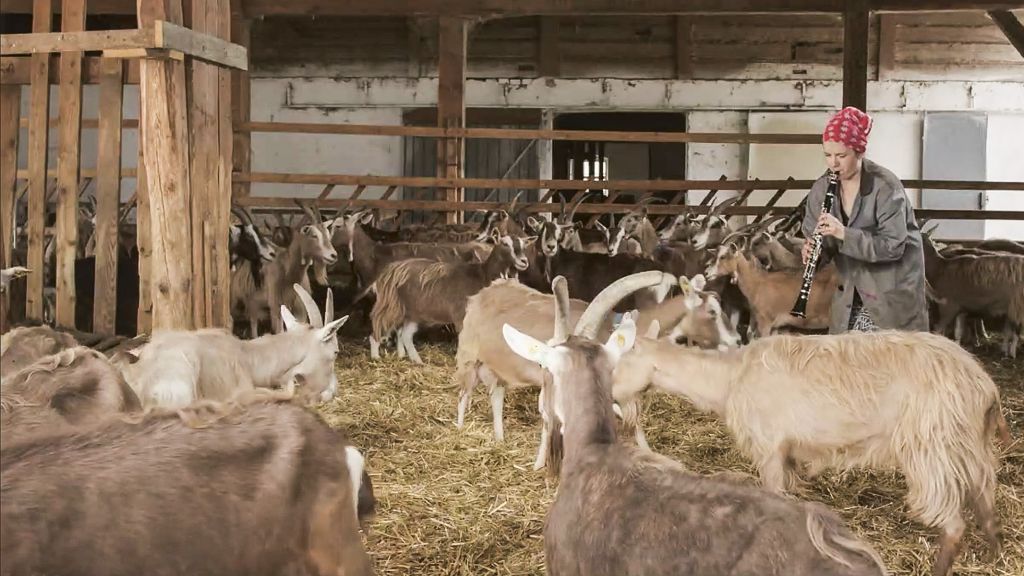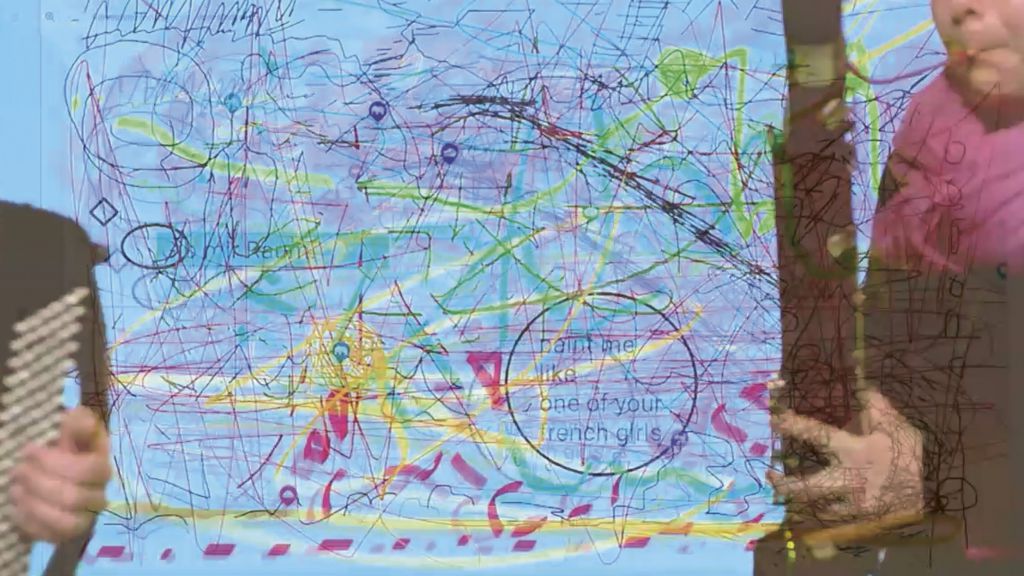When Musicians and Audience Enter into a Relationship
Concert Hall: Video Conference
“Jump out of your concert seats, take off your jackets, and pick up your tickets at the box office!” I glance at the rickety kitchen chair beneath me, three pages of Zoom tiles before me, and strain to remember just where in the apartment I put the furniture with the red velvet cushions. In what kind of concert mentality have I landed, here?
In one that’s been rethought. Hanne Pilgrim, Adrián Artacho, and the team of the artistic research project “Social d[ist]ancing” are performing György Ligeti’s Lux Aeterna in a Zoom meeting together with participants in the digital symposium “Rethinking Classical Music Practice”. A ticket link guided all of them to an active score in which each participant was responsible for a different part of the piece. The result was shared minutes filled with simultaneous music and silence—lived community.
“Rethinking Classical Music” and “Doing Community” were two crucial building blocks of the event “Rethinking Classical Music Practice. Audience and Community Engagement in Classical Concert Life.” This symposium, organised by Axel Petri-Preis (mdw) and Constanze Wimmer (KUG), spent three days exploring the question of how classical music life can—and indeed must—be rethought in the 21st century.
The contexts of this rethinking include not only music as such but also modes of performance and musician-audience contact. If one searches for the element that music-makers and listeners have in common, the question of whether one experiences music from the kitchen table or a seat upholstered in red velvet becomes superfluous. Far more important is: How can a connection be formed with what’s being listened to?
Meaningfulness in Old and New Spaces
Classical music life is characterised by highly effective exclusionary mechanisms. Clear evidence of such mechanisms is the comparatively low number of people who take advantage of what publicly funded cultural institutions have on offer. These institutions, stated Axel Petri-Preis, need—not least in light of late-modern society’s increasingly diverse character—to undergo a transformative process by which they overcome their elitist and hegemonic position, harnessing participative and distributional practices in order to render music meaningful to everyone. The way to a participative musical culture of this sort runs via audience engagement and community-building—and to this end, the needs of communities need to be paid more attention than has so far been the case.
Two concepts that exist to serve the ideals of inclusion, participation, and cultural democracy are music outreach and community music. A “Philippic” by Alicia de Bánffy-Hall and Constanze Wimmer served to sketch out their foundations and objectives while shedding light on differences and overlaps.
Where might classical music peer beyond the stage’s edge and begin thinking in new ways? For the contemporary work Stalltänze [Barn Dances] (composition: Petra Stump-Linshalm), clarinettist Barbara Neu chose a goat barn as her concert venue. In such a hall, there is no suitable place for a stage: Barbara Neu stood on the same level as all others in the room, moving among the bleating goats as she played her instrument. Here, something else became significant in addition to the music: Where do musicians play? How do they move through space? And are they at eye level with the audience? Such rethinking of concert spaces seeks not to demolish the Musikverein’s parquet flooring but rather to roll out an additional carpet for such an institution in other places—thereby opening up new participatory aspects.

Come together indispensably!
“How do we come to matter?” asks keynote speaker Doug Borwick, continuing with the simple answer: “By mattering”. The key to meaningful music, he holds, is indispensability. And what’s indispensable is a deep relationship with a community that is viewed as equal to the music’s performance itself. But how does one become meaningful? What gives rise to this deep connection to art—here, to classical music?
A production of West Side Story is of variable relevance to listeners from different milieus depending on where it’s performed. And in keeping with this, the cultural industry needs to become community-aware. Doing so entails precise consideration of what kind of performance will have real meaning for which audience.
Hannah Conway, artistic director of Sound Voice, likewise spoke about the necessity of a relationship between the people in the audience and those onstage. It’s true, she says, that all it takes to connect to music is curiosity—but for a longer-term relationship, curiosity will not suffice. To her, the most important thing is equality between the stages—and by stages, she means not only the mainstage but also the hall where the audience sits, in which everyone present should communicate.
The “We” in the Plural, the “I” in the “We”
The considerable potential of communities in music outreach is also a focus of sociologist Simon Güntner. Strong communities make for stable societies. And whereas community used to arise within villages and families, today we see the rise of entirely new—and in part short-term—forms of community. Individuals form new communities on the basis of common experiences that distinguish them from others. This idea can be transferred to music. Communities only ever exist in the plural: there is not one “true” community—instead, several exist in parallel.
Within these communities, however, there also exists the individual: Hannah Conway posed the question of just who the person behind music-making and music-experiencing is. She tells of a singer whose voice was damaged by cancer but wanted to give her children a memory of her voice. Out of this desire, a musical work arose with recordings of her healthy voice that included the sentence, “Your Mommy has cancer” interwoven with singing by her damaged voice following her illness. “We never hear changed or damaged voices”, says Hannah Conway. “Why not?” By involving sounds the are otherwise excluded, individuals who would otherwise have never come into contact with such sounds are reached and touched.
Contributions to Communities
The significance of personal identities was also emphasised by Rineke Smilde in her lecture, in which she linked the question of who one is as a musician with the aspiration to contribute something to society on that basis. She spoke about examples of music in the health sector in which musicians, patients, and caregiving staff make music with one another. In such cases, the notion of excellence—which occupies so much space in the concert industry—takes on a new meaning. Excellence, she said, while necessary with respect to musicality and technique, is all the more essential on a social level. Only via this wholistic approach can deeper communication arise between musicians and the audience. In the health sector, for example, caregivers can perceive the person behind dementia in a way that would not work in normal, everyday nursing and the usual structure of such relationships. Just such contributions to society can be made via a holistic music-making approach.
Burning Urgency: Injustices in Classical Concert Life
Rosa Reitsamer addressed problematic approaches to gender, race, and sexuality as they relate to the classical concert industry. She pointed out the inequality that characterises people’s access to classically-oriented institutions, which thereby draw invisible social boundaries. Concert attendees typically come from a milieu where concert attendance serves as a means of demonstrating social status as well as the associated tastes.
This type of exclusion has effects not only on individuals, but also the music itself. For historical reasons, various musics have been saddled with the attributes of “black” or “white”. Such racial marking has equipped “white” classical music, in its hegemony, with privileges and universal validity, while music by people of colour has been systematically excluded from concert halls.
A notable initiative against racism in concert life is represented by the Chineke Orchestra. Ishani O’Connor, this ensemble’s learning and participation manager, described in the roundtable discussion that followed how young musicians of colour are promoted in a targeted manner and how this orchestra rediscovers music by composers of African descent and enables it to be heard.
Listen critically!
So the situation is indeed urgent—for far more reasons than audiences’ absence due to the coronavirus pandemic. And it’s therefore all the more important to rethink and constantly reflect upon actual practice. Rosa Reitsamer called first and foremost for a push to overcome flawed cultural models. This already begins with listening. “Listen critically”, she said, meaning: How is our own listening influenced by gender, race, biography, and class? Only via an understanding of one’s own identity can one begin to perceive music in a nuanced manner. And an attitude of “creative justice”, she continued, would serve to centre the ideas of respect and equality of participation in classical music.

Community-Building at the Symposium
At this symposium, the absence of communities was a non-issue—for its participants and lecturers, musicians and audience members were kept continually involved: alongside hands-on workshops, there were also artistic activities to go with the performances in order to associate the lectures with one’s own learning and being.
Thanks to all this, the participants were able to truly share in the final words of musicians Maria Gstättner-Heckel and Stefan Heckel following their introductory improvisation: “We hope you enjoyed it; we certainly did.”
The symposium “Rethinking Classical Music Practice. Audience and Community Engagement in Classical Concert Life“ took place online from 25 to 27 Nov. 2021. The organisers were Axel Petri-Preis, senior scientist and deputy head of the IMP, and Constanze Wimmer, vice-rector of the KUG, in cooperation with Plattform Musikvermittlung Österreich as well as mica – music austria.
All lectures are available at YouTube.

